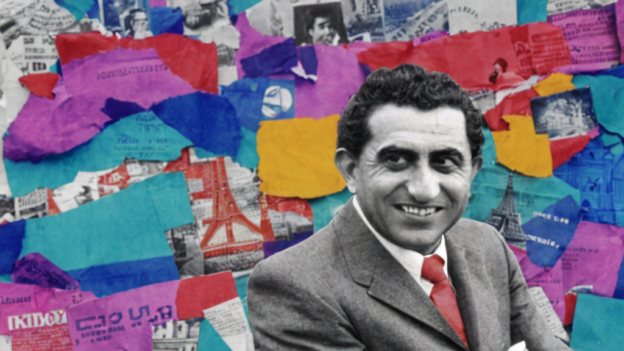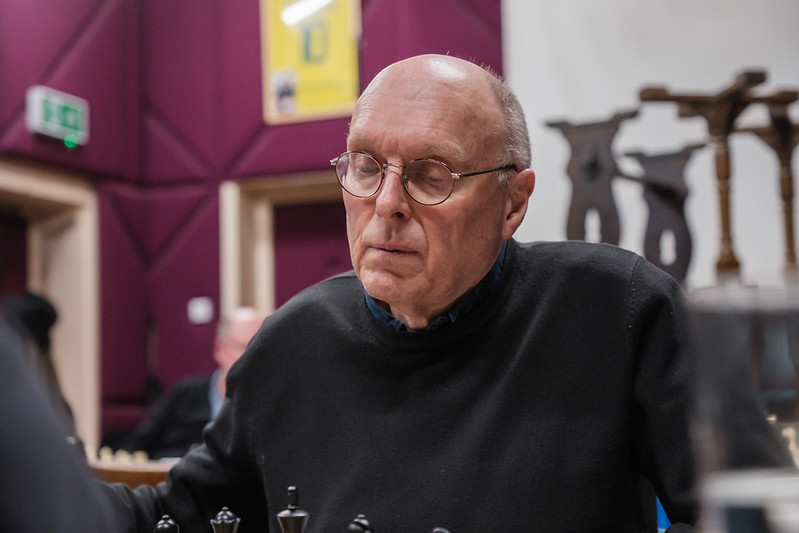The first of an occasional series in which Kingston members and friends of the club choose the player who has most inspired them. Illustration by Theo Esposito Bennett
One of the first chess books I ever owned was not really a book at all, but a very slim booklet, produced by the Soviet press, with minimal production values, which somehow found itself in a bookshop in London in 1969. It contained the games of the recently concluded world championship match. The contenders were the ninth champion, Tigran Petrosian, and his successor, Boris Spassky.
I understood few of the moves, but that added to the mysterious fascination of the event. If the play of these two masters had been at all comprehensible to me it would have meant that there was nothing exalted about it. Likewise, I felt somehow – or rather read somewhere – that Petrosian was himself a player of special mystery. The American chess writer Irving Chernev, in another of my early chess books (The Most Instructive Games of Chess ever Played), had encouraged this belief by his comment on the game Petrosian-Korchnoi, 1946: “Petrosian must have the spark of genius! How else could he, with a few mysterious moves, cause the quick collapse of so eminent a player as Korchnoi?” I wasn’t aware at the time that in 1946 Korchnoi was only 15 years old.
In 1946 Petrosian himself was only 16 or 17. His already exceptional talent had its roots in a very tough childhood, as described by the man himself in an interview in Life magazine in April 1969. According to this, his Armenian parents were illiterate and he was orphaned at a young age. Growing up in wartime Tbilisi, Georgia, he had to work as a road-sweeper to earn some roubles, or perhaps kopeks, to survive. This was clearly a formative experience.
“I started sweeping streets in the middle of winter,” Petrosian recalled, “and it was horrible. Of course, there were no machines then, and everything had to be done by hand. Some of the older men helped me out. I was a weak boy. And I was ashamed of being a street sweeper – that’s natural, I suppose. It wasn’t too bad in the early morning when the streets were empty, but when it got light and the crowds came out I really hated it.”
Petrosian was one of the golden generation of Soviet players who peaked in the 1960s. This also included Viktor Korchnoi, Mikhail Tal, Spassky and Efim Geller. All of them grew up in hard times: the second world war and the final years of Stalinism. To those of us who followed the chess of that era, each player seemed to have a distinct personality and style, but Petrosian’s style was probably the most singular.
One might speculate as to whether the experiences of his early years had an influence on this. With the kopeks saved from his road-sweeping he had bought Nimzowitsch’s My System, and he often afterwards stated how significant that positional chess manual had been for him. In his games there is usually an emphasis on the permanent features of the position – pawn structures, strong and weak squares, the long-term relative values of the pieces and so on. Curiously, like Mikhail Tal, Petrosian was known for his sacrifices, but, unlike Tal, Petrosian’s were often defensive, the most famous being his exchange sacrifices. Again, in contrast to Tal, Petrosian sacrificed material not to gain time but for long-term positional reasons.
As an example, here is the position after White’s 25th move in the game Reshevsky-Petrosian from the 1953 Candidates’ Tournament, Zurich:
However, with Petrosian it can sometimes be difficult to say whether a sacrifice like this is defensive or offensive. His game against Czech (and later German) grandmaster Vlastimil Hort from the 1970 European Team Championships is an example. Petrosian is Black and plays the Winawer Variation of the French Defence.
One reason Petrosian’s style attracted me was that commentors often referred to his deep understanding of the mysteries of positional chess. Of course, as a novice player, I was far from understanding even some basic aspects of the game, let alone its deep mysteries, but I was hopeful that studying Petrosian’s games might initiate me into some of these.
One aspect of his play which I could hope to find myself copying at my own undistinguished level was his pragmatism, in particular his readiness to make the moves required by the position even if they looked ugly or humbling. Petrosian seemed to be saying that it was OK to retreat a piece or to repeat a move if necessary. The following position in the fourth game of the world championship match against Mikhail Botvinnik in 1963 is an example of this.
In retrospect, I think another reason why I was drawn to Petrosian’s style of play was my misconception that if you were a master of strategy you didn’t need to worry so much about tactical details – and I was weak at tactics. In fact, as many commentators have noted, Petrosian was actually a superb tactician. You can’t base your game on strategy if the tactics are wrong. In addition, it’s been pointed out that Petrosian’s image as a purely defensive player is false. He could also play attacking combinations and, according to Spassky, “It is to Petrosian’s advantage that his opponents never know when he is suddenly going to play like Mikhail Tal.”
The 10th game from Spassky’s world championship match with Petrosian in 1966 must have been the kind of thing he had in mind. Petrosian has White against Spassky’s King’s Indian Defence.
Interestingly, Petrosian had perpetrated a very similar combination 10 years before on Vladimir Simagin (Petrosian-Simagin, Moscow Championship play-off 1956):
For more than a decade Petrosian fought his way through zonals, interzonals and candidates tournaments against his peers, until he finally qualified to play Botvinnik for the world title in 1963. He won this match convincingly 12.5-9.5. It might be said that he was fortunate that Botvinnik’s right to a return match had been abolished by Fide, but Petrosian proved he was a worthy champion by defending his title against Boris Spassky in 1966 with a score of 12.5-11.5. He lost to Spassky in 1969, but he remained one of the top players in the world until his death in 1984 at the early age of 55. He won the Soviet Chess Championship four times; the only players to record more wins were Botvinnik and Tal with six titles.
The ways in which Petrosian is sometimes described make it seem as if he inhabited a chess world of his own. This could be seen as implying either his limitations (he is often regarded as too cautious, with a very high percentage of draws) or as a sign of his unique understanding of the game. I have to accept that he did draw many games, but he also lost very few (his record playing for the Soviet Union in 10 Olympiads was +78, = 50, -1).
To conclude, in my view, playing through his best games can enrich any player’s understanding of chess’s infinite possibilities. This was brought home to me again recently when Kingston’s head of training, FM Julian Way, led an online discussion of the fifth game of the match with Botvinnik. It was a great choice; there is so much to learn from it.

